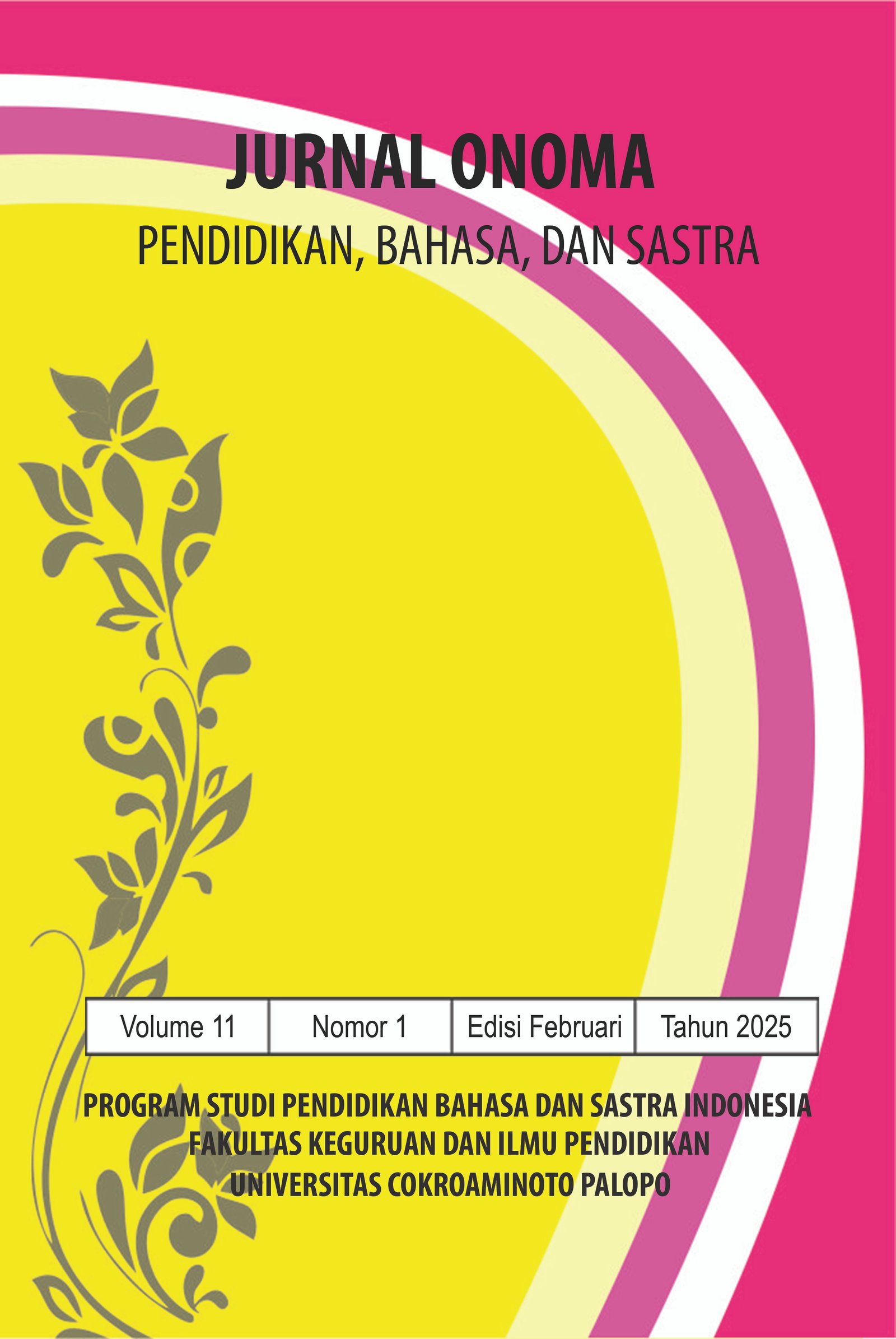Kepribadian Tokoh Utama dalam Novel Mariposa Karya Luluk HF Kajian Psikologi David Krech
https://doi.org/10.30605/onoma.v11i1.5217
Keywords:
Novel,David Krech,MariposaAbstract
Penelitian ini bertujuan untuk mendeskripsikan dan menganalisis konsep emosi teori David Krech yang terdiri dari konsep rasa bersalah,rasa bersalah yang dipendam,menghukum diri sendiri,rasa malu.kebencian,kesedihan dan cinta.Aspek dari penelitian ini yaitu dari 7 klasifikasi emosi tersebut.Data dari penelitian ini berupa kata-kata dan kalimat yang berupa dialog serta kata-kata dalam kalimat yang berupa narasi dalam bentuk klasifikasi emosi tokoh Acha dalam novel Mariposa karya Luluk HF.Sumber data pada penelitian ini ialah berupa novel Mariposa karya Luluk HF. Metode dan teknik pengumpulan data yang digunakan dalam penelitian ini adalah metode studi kasus dan catat.Adapun hasi dari penelitian saya bahwa dalam novel Mariposa karya Luluk HF terdapat klasifikasi emosi menurut teori David Krech seperti,konsep rasa bersalah,rasa bersalah yang dipendam,menghukum diri sendiri,rasa malu,kebencian,kesedihan dan cinta.
Downloads
References
Ahmad, A., & Muslimah, M. (2021, December). Memahami Teknik Pengolahan Dan Analisis Data Kualitatif. In Proceedings of Palangka Raya International and National Conference on Islamic Studies (PINCIS) (Vol. 1, No. 1).
Alwisol, A. (2004). Psikologi Kepribadian. Malang: Universitas Muhammyadiah Malang.
Amalia, P. R., Qodri, M. S., & Khairussibyan, M. (2022). Klasifikasi Emosi Tokoh Utama dalam Novel 00.00 Karya Ameylia Falensia: Kajian Psikologi David Krech. Jurnal Ilmiah Profesi Pendidikan, 7(3b), 1678-1683. DOI: https://doi.org/10.29303/jipp.v7i3b.830
Endaswara,Suwardi.(2008).Metodelogi Penelitian Sastra.Yogyakarta: Media Pressindo.
Fals, I., Dzarna, D., & Vardani, E. N. A. (2023). Nilai Nasionalisme Dalam Novel Habibie dan Ainun Karya Bcahruddin Jusuf Habibie Dengan Pendekatan Sosiologi Sastra. SASTRANESIA: Jurnal Program Studi Pendidikan Bahasa dan Sastra Indonesia, 11(3), 14-31.
Hamzah, I., Rusdiawan, R., & Mahyudi, J. (2022). Klasifikasi Emosi Tokoh Qais Al-Qarani Dalam Novel Layla Majnun Karya Nizami Al-Ganjavi: Kajian Perspektif David Krech. Jurnal Ilmiah Mandala Education, 8(2). DOI: https://doi.org/10.36312/jime.v8i2.3250
Haryani, M. A. T., Rahmawati, S. Y., & Kurniawan, E. D. (2024). Kepribadian Dan Emosi Tokoh Saka Dalam Novel Egosentris Karya Syahid Muhammad: Kajian Psikologi Sastra. Sintaksis: Publikasi Para ahli Bahasa dan Sastra Inggris, 2(1), 106-118. DOI: https://doi.org/10.61132/sintaksis.v2i1.274
Minderop, Albertine. 2010. Psikologi Sastra. Jakarta : Yayasan Pustaka Obor Indonesia.
Nafisa, Z., & Subandiyah, H. Klasifikasi Emosi Tokoh Utama Dalam Novl The Coldest Boyfriend Karya Itsfiyawn: Kajian Psikologi Sastra David Krech Serta Manfaatnya Dalam Pembelajaran Sastra Di SMA.
Nurfauziah, W., Mustika, I., & Priyanto, A. (2022). Analisis Tema Dan Amanat Dalam Novel Mariposa Karya Luluk Hidayatul Fajriyah. Parole: Jurnal Pendidikan Bahasa dan Sastra Indonesia, 5(2), 127-136. DOI: https://doi.org/10.22460/parole.v5i2.10901
Prawira, S. D. (2018). Karakter Tokoh Utama Pada Novel Entrok Karya Okky Madasari (Kajian Psikologi Sastra). Jurnal Ilmiah FONEMA: Jurnal Edukasi Bahasa dan Sastra Indonesia, 1(1), 1-15. DOI: https://doi.org/10.25139/fn.v1i1.1092
Rahman, M. M. M. A. (2023). Emosi Tokoh Utama dalam Novel Segala yang Diisap Langit Karya Pinto Anugrah Serta Implikasinya dalam Pembelajaran Sastra Di SMA. Inovasi Pendidikan, 10(1). DOI: https://doi.org/10.31869/ip.v10i1.4459
Septiana, A. (2020). Klasifikasi Emosi Tokoh Nathan dalam Novel Dear Nathan Karya Erisca Febriani: Kajian Perspektif David Krech: Nathan’s Emotion Classification in The Novel Dear Nathan By Erisca Febriani: Study of David Krech’s Perspective. Jurnal Bastrindo, 1(1), 17-31. DOI: https://doi.org/10.29303/jb.v1i1.16
Surijah, E. A., Sabhariyanti, N. K. P. D., & Supriyadi, S. (2019). Apakah Ekspresi Cinta Memprediksi Perasaan Dicintai? Kajian Bahasa Cinta Pasif dan Aktif. Psympathic: Jurnal Ilmiah Psikologi, 6(1), 1-14. DOI: https://doi.org/10.15575/psy.v6i1.4513
Utami, R. R., & Asih, M. K. (2017). Konsep diri dan rasa bersalah pada anak didik lembaga pemasyarakatan anak kelas IIA Kutoarjo. Jurnal Dinamika Sosial Budaya, 18(1), 123-132 DOI: https://doi.org/10.26623/jdsb.v18i1.563
.
Downloads
Published
How to Cite
License
In submitting the manuscript to the journal, the authors certify that:
- They are authorized by their co-authors to enter into these arrangements.
- The work described has not been formally published before, except in the form of an abstract or as part of a published lecture, review, thesis, or overlay journal.
- That it is not under consideration for publication elsewhere,
- That its publication has been approved by all the author(s) and by the responsible authorities – tacitly or explicitly – of the institutes where the work has been carried out.
- They secure the right to reproduce any material that has already been published or copyrighted elsewhere.
- They agree to the following license and copyright agreement.
License and Copyright Agreement
Authors who publish with Onoma Journal: Education, Languages??, and Literature agree to the following terms:
- Authors retain copyright and grant the journal right of first publication with the work simultaneously licensed under Creative Commons Attribution License (CC BY 4.0) that allows others to share the work with an acknowledgment of the work's authorship and initial publication in this journal.
- Authors are able to enter into separate, additional contractual arrangements for the non-exclusive distribution of the journal's published version of the work (e.g., post it to an institutional repository or publish it in a book), with an acknowledgment of its initial publication in this journal.
- Authors are permitted and encouraged to post their work online (e.g., in institutional repositories or on their website) prior to and during the submission process, as it can lead to productive exchanges, as well as earlier and greater citation of published work.

















